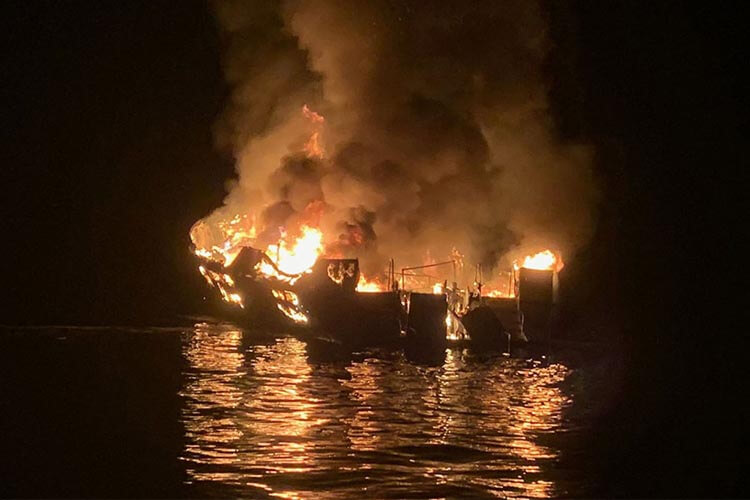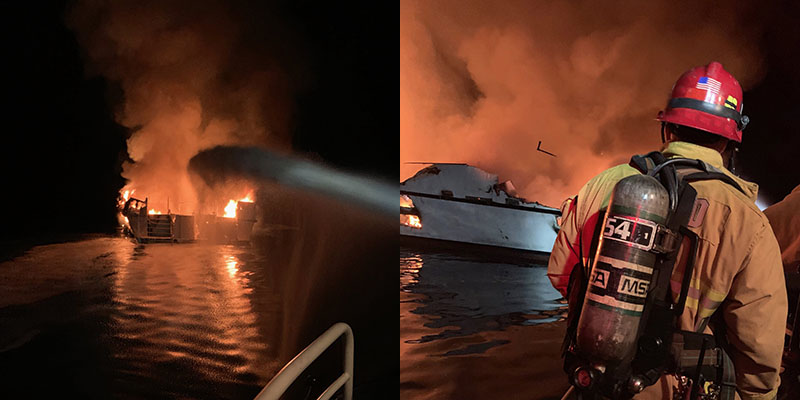
By DIVE Staff
Attorneys in California have filed a lawsuit citing negligence on behalf of the owners of the Conception, which caught fire off the coast of California in September 2019 killing all 33 passengers and one crew member on board.
The action has been brought by relatives of four of the victims to counter to a lawsuit filed by the boat’s owners shortly after the tragedy occurred, which sought to absolve them of financial responsibility for the incident using a California maritime law from 1851. Glen and Dana Fritzler of Truth Aquatics, who owned the Conception, argued that they had, at all times, ‘used reasonable care to make the Conception seaworthy,’ which would, under the 1851 law, entitle victims of the fire to compensation based on the market value of the burned-out hull of the vessel.
The incident occurred shortly after 3am on 2 September 2019 as the Conception was moored off the coast of Santa Barbara on the final night of a three-day trip around Santa Cruz Island. After a birthday party celebration, the passengers retired to the sleeping quarters on the lower deck, from which they were unable to escape once the fire broke out. The fire is believed to have started in the galley and burned the Conception to the waterline. Five crew members who were sleeping on the upper deck survived.
An initial report into the disaster conducted by the National Transportation Safety Board (NTSB) concluded that all crew members on board were asleep at the time the fire broke out, in direct contravention of maritime law. An official statement as to the cause of the fire has yet to be released, but one widely reported theory is that the fire began as a result of the failure of a lithium battery in the Conception’s charging area, which was located in the galley.

In an interview with the Washington Post, lawyer Robert Mongeluzzi, representing the victims, called the owner’s attempt to limit liability for the action ‘outrageous and inhumane, and a slap in the face [for the] grieving families.’ Mongeluzzi said that the NTSB’s investigation pointed to failures on behalf of Truth Aquatics which led to the tragedy occurring.
‘There was no night watch, there wasn’t adequate training, the location of the charging stations in a level above the sleeping berth with multiple electronic devices with ion batteries was a death trap,’ he said. ‘Federal law requires that there be a night watch to prevent the very tragedy that occurred. We believe that we’re going to be able to prove that there was no night watch, not on this voyage and not on other voyages, and that their crew was not trained.’
In addition to the alleged lack of an appropriate night watch by the crew, the prosecuting attorneys say that the Conception’s design did not allow for the safe evacuation of 34 passengers from the sleeping quarters as both exits – a stairway and a small hatch above one of the bunks – were insufficient for all the passengers to escape and both led to the galley, where it is believed the fire began.
The lawsuit has potential implications for the future of maritime safety regulations. It has been noted that the Conception was built in 1981, long before rechargeable lithium-ion battery-powered devices such as dive lights, cameras and smartphones were invented. The Conception’s ‘charging station’ was – like many liveaboards around the world – a power strip installed in a convenient location.
The Washington Post also reports that in the wake of the disaster, California lawmakers introduced a bill ‘focused on boat safety that would in part mandate that all small passenger vessels have at least two modes of egress’
The new lawsuit adds to two that have already been filed against Truth Aquatics, one on behalf of a surviving crew member claiming he was improperly trained, and a second for wrongful death brought by the wife of one of the victims.


